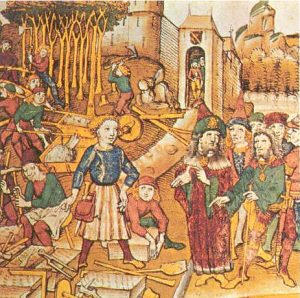Medieval (about 476AD-1600’s)
16 Medieval Technology
Hanna Woody
Introduction
During the Medieval Period, several key inventions were created to help everyday life in different social classes. These inventions were just the beginning of many more developments to occur later in the future. Ground breaking inventions during this time include bridges, mechanical clock, printing press, and windmills.
Connection to STS
During the medieval time period new advanced technology were created that changed the world forever. The benefits the new technology had on society included more efficient travel, more widespread knowledge, and different form of power. In order to advance society further new technology had to be created.

Bridges
The system of bridges altered the way people could travel; decreasing travel time and risk. The construction and engineering of bridges in medieval times were remarkable achievements, comparable to the great cathedrals of the period, reflecting the sophistication and importance of road transport and the medieval economy Harrison (2007). Additionally, medieval bridges were crucial for overcoming natural obstacles such as rivers, enabling terrestrial movement and trade in various regions (Murrieta-Flores & Williams, 2017). The benefits of medieval bridges extended beyond transportation and trade. They also served as vital infrastructure for the development and organization of medieval cities. Moreover, the presence of these bridges contributed to the establishment and growth of settlements, as they provided essential links across rivers and facilitated movement within and between urban areas (Pydyn & Popek, 2020).b

Mechanical Clocks
The development of clocks in medieval times marked a significant technological advancement that revolutionized timekeeping and had far-reaching societal implications. Mechanical clocks, driven by weights and springs, were introduced during this period, offering greater time accuracy due to improved design and materials (Wagner & Knaub, n.d.). These innovations in timekeeping benefited medieval societies, enabling the accurate determination and registration of religious festivals and working time (Sinha, 2013). Monks were the main users of the clock to keep up with prayer times. The mechanical clocks always helped the working class with both employees and employers; creating a more fair and balance work hours The first mechanical clocks could only kept up with the hours not minutes in the 14th century, but by the 15th century both hours and minutes were accounted for on the clocks.
Printing Press
The printing press, developed by Johannes Gutenberg in the 15th century, transformed the dissemination of information, making knowledge more accessible and revolutionizing education and communication. Gerard Leeu and his contemporaries introduced the use of printed books for religious instruction, paving the way for developments in the sixteenth century (Dlabacova, 2020). One of the firs major projects of the Gutenberg printing press was the 42-line bible. The printing press would eventually be one of the main reasons why the Europe renaissance could occur.
Windmills
The use of windmills for grinding grain, pumping water, and generating power increased productivity and efficiency in agricultural and industrial processes, contributing to improvements in everyday life for people living during this time . The development and use of windmills in medieval times represented a significant technological advancement in harnessing wind energy. The historical significance of windmills is further emphasized by the examination of the wind energy revolution, providing a comprehensive review of the long history of wind energy utilization Hammond & Waldron (2008). Many industrial milling innovations, including windmills, were transmitted to medieval Europe from Asia and the Islamic world, highlighting the interconnectedness of technological advancements during that period (Hammond & Stapleton, 2001). The historical context of wind energy usage is also relevant in the contemporary debate over alternative energy strategies, as it underscores the reliance on renewable energy sources derived from solar energy in the pre-industrial period (Pytel et al., 2019).
Conclusion
These inventions played a crucial role in shaping the daily lives of people during the Medieval Period and laid the foundation for further technological advancements in the centuries that followed.
Chapter Questions
- Who developed the printing press?
- What century were mechanical clocks developed?
- What were windmills used for?
- What is one benefit of bridges?
Ai Use Disclosure
I used scite.ai to help me find information about Medieval technology that fits the goals of this textbook chapter. It gave me a more variety of sources to use. I then used the other sources I had gathered to apply other elements to the chapter.
scite.ai. (2023). scite.ai (beta version) [Large Language Model]. https://scite.ai/assistant
References
Dlabacova, A. (2020). Printed pages, perfect souls? ideals and instructions for the devout home in the first books printed in dutch. Religions, 11(1), 45. https://doi.org/10.3390/rel11010045
Hammond, G. and Waldron, R. (2008). Risk assessment of uk electricity supply in a rapidly evolving energy sector. Proceedings of the Institution of Mechanical Engineers Part a Journal of Power and Energy, 222(7), 623-642. https://doi.org/10.1243/09576509jpe543
Harrison, D. (2007). The bridges of medieval england.. https://doi.org/10.1093/acprof:oso/9780199226856.001.0001
Printing press *Johannes Gutenberg. Medieval Chronicles. (2022b, December 1). https://www.medievalchronicles.com/medieval-history/medieval-inventions-list/printing-press/
Pydyn, A. and Popek, M. (2020). A third medieval bridge on lake lednica, greater poland. Archeologické Rozhledy, 72(3), 450-469. https://doi.org/10.35686/ar.2020.16
Pytel, K., Gumuła, S., Dudek, P., Bielik, S., Szpin, S., Hudy, W., … & Kowalski, M. (2019). Testing the performance characteristics of specific profiles for applications in wind turbines. E3s Web of Conferences, 108, 01015. https://doi.org/10.1051/e3sconf/201910801015
Mechanical clock. Medieval Chronicles. (2022, December 1). https://www.medievalchronicles.com/medieval-history/medieval-inventions-list/mechanical-clock/
Murrieta-Flores, P. and Williams, H. (2017). Placing the pillar of eliseg: movement, visibility and memory in the early medieval landscape. Medieval Archaeology, 61(1), 69-103. https://doi.org/10.1080/00766097.2017.1295926
Sinha, C. (2013). Niche construction, too, unifies praxis and symbolization. Language and Cognition, 5(2-3), 261-271. https://doi.org/10.1515/langcog-2013-0019
Wagner, J. and Knaub, K. Time keeping experiments for a mechanical engineering education laboratory sequence.. https://doi.org/10.18260/1-2–4758
Images Cited
“Medieval bridge, St. Ives” by Rob Noble is licensed under CC BY-SA 4.0
“Middle Ages” is in the Public Domain

